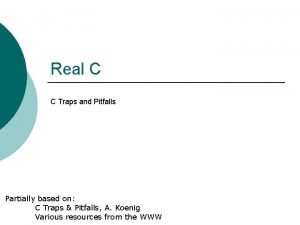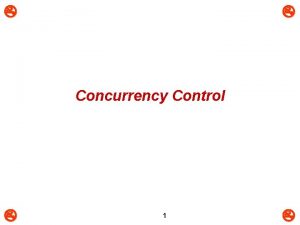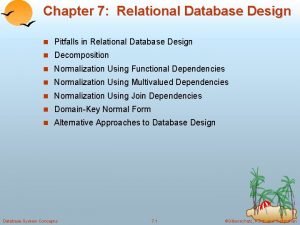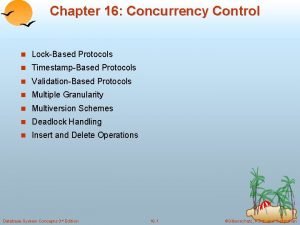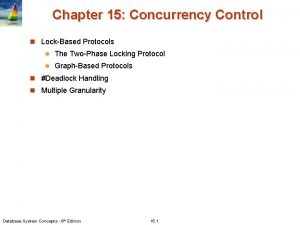Discussion of The Promises and Pitfalls of Factor









- Slides: 9

Discussion of “The Promises and Pitfalls of Factor Timing” Josephine Smith, Ph. D, Director, Factor-Based Strategies Group at Black. Rock

Overview of Discussion This paper addresses a hot topic in factor investing: Can investors outperform through dynamic allocation across equity style factors? Without giving it all away, the answer is yes, but with caveats… The authors focus on the relationship between several empirical predictors of factor performance, and emphasize the importance of investment horizon. Different predictors of factor performance are relevant for different factors and different horizons. This paper fits in the broader literature of factor timing/tilting/rotation. My colleagues at Black. Rock have a forthcoming paper in the Journal of Portfolio Management asking a similar question through the lens of implementable portfolio construction using mean-variance optimization. 1 In that paper, they look at both time-series and cross-sectional predictors of equity style factors. We currently manage a Factor Rotation strategy at Black. Rock that harnesses the results of that work, implementing the quantitative insights with i. Shares® Smart Beta ETFs. Henceforth, I am going to refer to this type of strategy as factor timing in the spirit of this paper. 1 Ang, A. , Hodges, P. , Hogan, K. and Justin Peterson, 2017. “Factor Timing with Cross-Sectional and Time-Series Predictors. ” Forthcoming, Journal Portfolio Management. of

The Definition of Factors and Factor Investing The authors define a factor as “an attribute relating a set of securities’ returns. ” The focus in this paper is only on equity style factors, as opposed to macro factors or other multi-asset factors. One could say, however, that there are “macro” factors in this analysis… An alternative definition of a factor is a broad, persistent source of return. The key to this definition is that the return is persistent over a long-run horizon. The idea of factor timing is to take advantage of the fact that this is a long-run definition. The authors do key into the three main drivers of factor performance that we also use at Black. Rock: Risk premiums, structural impediments, and behavioral biases. The success of factor investing is predicated on the fact that these style factors are not only broad, persistent sources of return, but they are diversifying to each other. Value and momentum have a natural negative correlation to each other. Are these correlations always stable? No, and this is also why factor timing can work, if you think you can time market conditions when correlations can spike…

Factor Predictors I think the authors should take more care in how they define factor predictors: Are they time-series or crosssectional predictors? The academic and practitioner literature is mixed on these dimensions. Exhibits 4 and 5 (performance of the valuation predictor) were difficult to understand. How can you distinguish market sentiment and momentum? Are the sensibilities related? Are the authors worried about data issues with respect to some of the indicators? The authors point out that data revisions for macro data are a problem. Why not use the real-time data? Datastream (etc. ) has it. Why is the TERM spread 20 yr – 3 mo? Robustness? I like the authors using both price-base and non-price-based factor predictors. Is there worry around whether using something like the TED spread is really just picking up momentum? Predicting returns with returns… How correlated are these factor predictors?

Relating Factor Predictors to Long-Only FF Factors The authors use the long-only Fama-French representative factor portfolios. Why is low volatility not a factor in your view? You specified it was in the introduction, and it is the most helpful factor in an economic downturn (especially in long-only space). Why not use other factor portfolios (MSCI indices, etc. )? Or construct your own? The correlations in Exhibits 9 -11 provide some full-sample insights. I think there are some typos in the exhibit descriptions; I had a hard time figuring out why they were showing. It’s not surprising that the relationship between the predictors and factor returns is highest at longer horizons. The authors realize cherry-picking factor predictors is important, but the key with factor investing is relying on the long-run performance of the factors. Part of the reason certain predictors may not seem to work so well in Exhibit 14 is because of the portfolio construction technique being used (by FF) rather than simply the predictor itself. However, it is the case that predictors have cyclicality in out-of-sample performance, but that’s why they should be combined in the portfolio construction process.

Business Cycle Indicators and Factor Performance It is the opinion of this discussant that, without a doubt, the single most important predictor of future factor performance is the economic regime. The figures to the right show the economic regime indicator we use in our Factor Rotation strategy, as well as the unconditional and regime-conditional Sharpe ratios of the MSCI USA Smart Beta indices. Have the authors quantified how their economic and/or financial variables relate more systematically to economic regimes and the sensibility behind why certain factors outperform in certain regimes? Indeed, understanding future economic regimes will not only aid in understanding when a single factor might outperform a market-cap index, but it can also have potential predictive information as to when one factor insight might outperform another factor insight. Example: In expansions, momentum and value will, on average, outperform the remaining style factors in equities. This should be fundamental to any factor timing strategy. Source: Ang, A. , Hodges, P. , Hogan, K. and Justin Peterson, 2017. “Factor Timing with Cross-Sectional and Time-Series Predictors. ”

Bringing Factor Timing Together The paper focuses 90% of its effort on the relationship between factor predictors and the longonly, FF factor portfolios. It’s only in the very last section, last paragraph that the authors show a more holistic approach to factor timing, though they don’t go into many details about the construction of the portfolio. More work can be done here, and is in line with the paper cited previously and could be additive. The model presented in that paper is actually implementable. Is this one? What instruments are being used? How are the instruments constructed? How are the factor predictors constructed? And so on and so forth… this is the interesting part! It’s not about giving up the secret sauce… The authors say this, but it bears repeating: A strategic portfolio equally-weighted across diversifying equity style factors will outperform a market-cap index. If you want to go beyond this, it’s important to understand where you are taking your active risk (relative to the equal-weighted factor portfolio and/or the market-cap portfolio). If it’s relative to market-cap, how much of it is just being low beta? The GFC is a huge outlier in the sample period, and maybe beta-adjusted performance should be analyzed?

Conclusion A fruitful area of research, so thanks for letting me discuss this paper!

Important notes This material is provided for educational purposes only and is not intended to constitute investment advice or an investment recommendation within the meaning of federal, state or local law. You are solely responsible for evaluating and acting upon the education and information contained in this material. Black. Rock will not be liable for direct or incidental loss resulting from applying any of the information obtained from these materials or from any other source mentioned. Black. Rock does not render any legal, tax or accounting advice and the education and information contained in this material should not be construed as such. Please consult with a qualified professional for these types of advice. This material is not intended to be relied upon as a forecast, research or investment advice, and is not a recommendation, offer or solicitation to buy or sell any securities or to adopt any investment strategy. The opinions may change as subsequent conditions vary. The information and opinions contained in this material are derived from proprietary and nonproprietary sources deemed by Black. Rock to be reliable, are not necessarily all inclusive and are not guaranteed as to accuracy. There is no guarantee that any of these views will come to pass. Past performance is not indicative or predictive of future performance. These materials are neither an offer to sell nor a solicitation of any offer to buy shares in any fund. You may not rely upon these materials in evaluating the merits of investing in any fund that employs any of the strategies referred to herein. Any reference herein to any security and/or a particular issuer shall not constitute a recommendation to buy or sell, offer to buy, offer to sell, or a solicitation of an offer to buy or sell any such securities issued by such issuer. There can be no assurance that the investment objectives of any strategy referred to herein will be achieved. An investment in any strategy referred to herein involves a high degree of risk, including the risk that the entire amount invested may be lost. For use with institutional investors only
 Fractional distillation conclusion
Fractional distillation conclusion C traps and pitfalls
C traps and pitfalls The perils and pitfalls of leading change case solution
The perils and pitfalls of leading change case solution Latchup in vlsi
Latchup in vlsi What are pitfalls in differentiation
What are pitfalls in differentiation What are two pitfalls (problems) of lock-based protocols
What are two pitfalls (problems) of lock-based protocols Question pitfalls
Question pitfalls What is pitfalls in relational database design
What is pitfalls in relational database design What are two pitfalls (problems) of lock-based protocols
What are two pitfalls (problems) of lock-based protocols What are two pitfalls (problems) of lock-based protocols
What are two pitfalls (problems) of lock-based protocols

